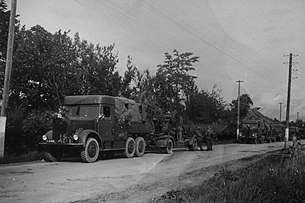Slovak National Uprising
| Slovak National Uprising | |||||||
|---|---|---|---|---|---|---|---|
| Part of World War II | |||||||
 Convoy of Slovak insurgent army vehicles near Kelemeš (today part of Prešov) |
|||||||
|
|||||||
| Belligerents | |||||||
| Commanders and leaders | |||||||
|
|
|
||||||
| Strength | |||||||
| 40,000, later increased to 83,000 | 18,000 initially, later increased to 78,000 | ||||||
| Casualties and losses | |||||||
| ≈10,000 | ≈10,000 + 5,304 captured and executed | ||||||
German and collaborator victory
![]() 1st Czechoslovak Army in Slovakia
1st Czechoslovak Army in Slovakia
The Slovak National Uprising (Slovak: Slovenské národné povstanie, abbreviated SNP) or 1944 Uprising was an armed insurrection organized by the Slovak resistance movement during World War II. This resistance movement was represented mainly by the members of the Civic democratic movement, but also by representatives and members of the pre-war Social democrats and Communists albeit on a smaller scale. It was launched on 29 August 1944 from Banská Bystrica in an attempt to resist German troops that had occupied Slovak territory and to overthrow the collaborationist government of Jozef Tiso. Although the resistance was largely defeated by German forces, guerrilla operations continued until the Soviet Army, Czechoslovak Army and Romanian Army liberated Slovakia in 1945.
...
Wikipedia
